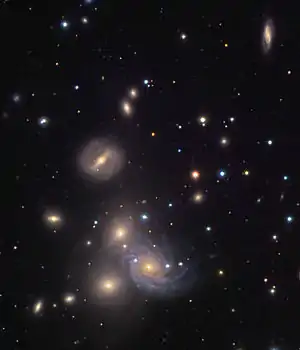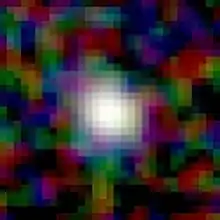NGC 67
NGC 67 is an elliptical galaxy located in the constellation Andromeda that was discovered on October 7, 1855 by R. J. Mitchell, who described it as "extremely faint, very small, round". The galaxy belongs to the NGC 68 group, which also contains the galaxies NGC 68, NGC 69, NGC 70, NGC 71, NGC 72, and possibly NGC 74.
| NGC 67 | |
|---|---|
 the NGC 68 group, with NGC 67 and NGC 67a at the far bottom left, next to elliptical galaxy NGC 68 | |
| Observation data (J2000 epoch) | |
| Constellation | Andromeda |
| Right ascension | 00h 18m 12.18s |
| Declination | 30° 03′ 17.5″[1] |
| Redshift | 0.020734[2] |
| Helio radial velocity | 6216 km/s |
| Distance | 275,000,000 ly[3][4] |
| Group or cluster | NGC 68 group |
| Apparent magnitude (V) | 14.2[4][5] |
| Characteristics | |
| Type | E5[5] |
| Size | 40,000[4] |
| Apparent size (V) | 24" x 12"[5] |
| Other designations | |
| VV 166g 2MASX J00181219+3003195 2MASXi J0018121+300320 GALEXASC J001812.17+300320.0 HOLM 006E SRGb 062.046 LEDA 138159[2] | |
| NGC 67a | |
|---|---|
 image of NGC 67a from the 2MASS survey | |
| Observation data | |
| Constellation | Andromeda |
| Right ascension | 00h 18m 14.83s |
| Declination | 30° 03′ 45″ |
| Redshift | 0.022162[2] |
| Helio radial velocity | 6644 km/s |
| Distance | 300,000,000 ly[3] |
| Group or cluster | NGC 68 group |
| Apparent magnitude (V) | 14.5 |
| Characteristics | |
| Type | E3 |
| Size | 35,000 |
| Apparent size (V) | 23" x 20"[1] |
| Other designations | |
| VV 166f ARK 004 CGCG 499-104 CGCG 0015.6+2947 MCG +05-01-064 2MASX J00181481+3003475 2MASXi J0018148+300347 GALEXASC J001814.89+300347.6 WBL 007-006 HOLM 006G PGC 001185 SRGb 062.048[2] | |
Target galaxy controversy
Mitchell's position locates the observed galaxy between an E3 elliptical and an E5 elliptical on the edge of the galaxy group, and each elliptical has been interpreted as the original and secondary. Wikisky lists the round galaxy as the primary and the elongated as PGC 138159,[1] the Deep-Sky Objects browser lists the elongated as NGC 67,[5] NED lists the same galaxy as both NGC 67 and NGC 67a.[2] Courtney Seligman's NGC object database argues, however, that since the location offset of NGC 67 is similar to that of the other galaxies in the group, that the elongated galaxy is likely the observed object, and that the rounder NGC 67a was listed as a star by Mitchell.[4]
References
- "PGC 138159 - Galaxy - WIKISKY". WIKISKY. Retrieved 13 May 2014.
- "NED search results for NGC 67". NASA/IPAC Extragalactic Database. NED. Retrieved 13 May 2014.
- Wright, Ned. "Ned Wright's Javascript Cosmology Calculator". UCLA. Retrieved 13 May 2014.
- "New General Catalog Objects: NGC 50 - 99". cseligman.com. Retrieved 13 May 2014.
- "NGC 67 > Deep Sky Objects Browser". dso-broser.com. DSO Browser. Retrieved 13 May 2014.